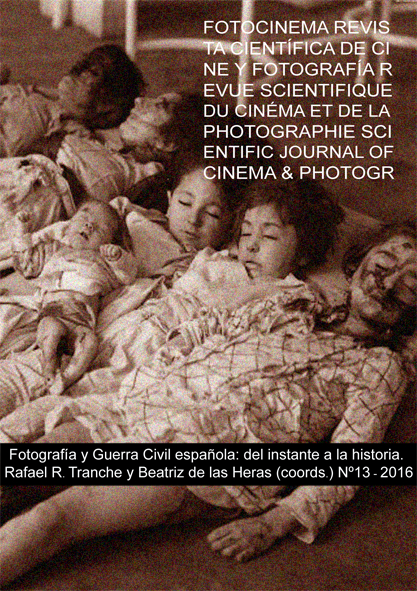La (po)ética del instante: testimonios, mitos e ironías del fotoperiodismo (1936-1939)
DOI:
https://doi.org/10.24310/Fotocinema.2016.v0i13.6058Abstract
El periodo de la Guerra Civil española tuvo un papel crucial en el establecimiento del fotoperiodismo y sus formas visuales, todavía hoy vigentes. Este marco dio lugar a dos de los grandes hitos del siglo XX: Robert Capa y su imagen más universal, El miliciano muerto. Este estudio analiza el proceso de creación de ambos mitos, donde la participación de la fotógrafa Gerda Taro resultó esencial tanto en la creación de la imagen pública del fotógrafo como en el asentamiento de la fotografía como conmoción, una de las formas más duraderas del periodismo gráfico. Paralelamente, ha sido necesario un estudio de la imagen como clisé que analizara los usos de estas fotografías como parte fundamenteal en la construcción de ambos hitos.
Abstract:
The period of the Spanish Civil War played a crucial role in the establishment of photojournalism and visual forms, still relevant today. This framework led to two of the great milestones of the Twentieth Century: Robert Capa and his most universal photograph, The falling soldier. This research analyzes the process of creating both myths, where the participation of the photographer Gerda Taro was essential in the creation of the public image of the photographer and the consolidation of photography as a shock, one of the most enduring genres of photojournalism. Similarly, it is necessary to study the image as a reproduction to analyze the uses of this work as a fundamenteal part in the construction of both milestones.
Palabras clave:
Gerda Taro; fotoperiodismo; Guerra Civil española; iconografía de guerra; Robert Capa.
Keywords:
Gerda Taro; Photojournalism; Spanish Civil War; War Iconography; Robert Capa.
Downloads
Metrics
Publication Facts
Reviewer profiles N/A
Author statements
Indexed in
-
—
- Academic society
- N/A
- Publisher
- Universidad de Málaga
Downloads
Published
How to Cite
Issue
Section
License
All contents published in Fotocinema Revista científica de cine y fotografía are protected under the Creative Commons Attribution-NonCommercial-ShareAlike 4.0 International (CC BY-NC-SA 4.0) license. All about this license is available in the following link: <http://creativecommons.org/licenses/by-nc-sa/4.0>
Users can copy, use, redistribute, share and exhibit publicly as long as:
- The original source and authorship of the material are cited (Journal, Publisher and URL of the work).
- It is not used for comercial purposes.
- The existence of the license and its especifications are mentioned.
There are two sets of authors’ rights: moral and property rights. Moral rights are perpetual prerogatives, unrenounceable, not-transferable, unalienable, imprescriptible and inembargable. According to authors’ rights legislation, Fotocinema. Revista científica de cine y fotografía recognizes and respects authors moral rights, as well as the ownership of property rights, which will be transferred to University of Malaga in open access. The property rights are referred to the benefits that are gained by the use or the dissemination of works. Fotocinema. Revista científica de cine y fotografía is published in an open access form and it is exclusively licenced by any means for doing or authorising distribution, dissemination, reproduction, , adaptation, translation or arrangement of works.
Authors are responsable for obtaining the necessary permission to use copyrighted images.














13.png)



